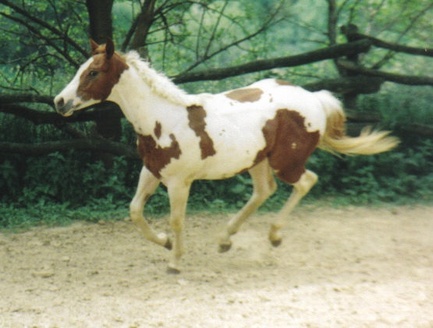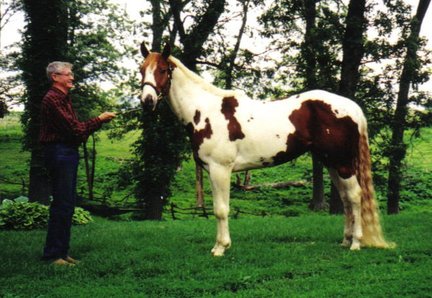 I first met him as a suckling foal. When he came to me for training it was a fuzzy-coated weanling. Tall, lanky and long-eared I fell in love with this colt from day one. There was something about his personality, his willingness to learn, his bravery and his ability to trust so willingly which tugged at my heart. He was a special colt and immediately became my favorite. The spring of his weanling year the colt (whom I'd named Farley) came down with a respiratory infection. Just like with young children, a runny nose and a cough are not cause for serious concern -- we treated Farley and he soon recovered. However, a short time later he came down with another infection, recovered and then took ill again. I spent a lot of time caring for Farley during this time...when he was well, I taught him his first lessons: wearing a halter, leading, tying, picking up his hooves and free-longeing. When Farley was sick I would brush him and talk to him, wipe his nose and give him his medicine. By summer of his yearling year (pictured above), Farley was a strong and healthy stud colt. He was blood-typed as homozygous (meaning he would always produce a patterned foal) which made him a valuable breeding prospect. Farley also had outstanding conformation and was a beautiful, natural mover ideal for western pleasure where they value a slow jog-trot and a natural slow lope (canter). I continued his basic ground training and introduced him to a bit and bridle, the feeling of a surcingle around his body and how to respond to rein pressure. In the late spring of his two-year-old year, I began to introduce Farley to the saddle and to ground driving. He took to it as if he had been driving all his life -- never a buck or objection. He naturally carried his head low and traveled slow and steady. He was beautiful to watch and I marveled at his natural ability. Later that year we introduced him to the weight of a rider -- with absolutely no objection, Farley jogged around the round pen as if he had been broke to ride for years. Farley continued to make progress in his training that year. I was careful not to push him -- it was important to me that he was always calm and happy. In the fall of that year I noticed Farley taking a short step with his right hind leg. He seemed unwilling to bring the leg fully under his body and it seemed to kind of trail along behind him -- just a little bit off the pace. He didn't seem uncomfortable and I could find no heat or pain in the leg so we decided to rest him for a while and see how he went in a month or so. When Farley returned to work he still had that slight short step with his hind leg. He'd drag his toe a bit and was asymmetrical in his movement. I could still find no pain in the leg or in his back or hips. Thinking perhaps he was being lazy, I tried extending his trot -- though he took a longer step, his right hind was still stepping shorter than the left hind. I consulted with Farley's owner and we decided to take him to the vet for a full work-up. The vet performed a few neurological tests and Farley tested positive for potential neurological damage. The vet suspected Equine Protozoal Myeloencephilitis (EPM). At that time (2000) the only way to determine if Farley had EPM was to do a spinal tap. I left Farley at the vet so they could anesthetize him in the morning and perform the spinal tap. The test results came back as positive for EPM. EPM is a parasitic attack on the horse's spine impacting the central nervous system. A horse with EPM will lose feeling in the affected area of the spine and the limbs associated with that area. This is why Farley was not using his leg properly -- he could no longer feel it. In 2000, EPM was considered a career-ending and possibly life-ending disease. If the parasite could not be stopped, it would eventually follow the spine into the brain and kill the horse. There was a very expensive, time-consuming, messy treatment which had had minimal success. In most EPM cases, if any improvement was made it was often short-lived and the horse never regained proper use of the affected legs. There was also a strong incidence of relapse. Farley's owners opted to treat his EPM. The vet was optimistic as Farley was only two-years-old and we had caught it relatively early. Farley began as six-month treatment where he was give 60cc of gooey paste in his mouth, three times a day. He could not eat four hours before or two hours after his medicine. For six months Farley (a young stallion) was on stall-rest and minimal food intake. He became very skinny and his muscles wasted away but he survived the treatment and beat the EPM. He is pictured below about a month after his treatment ended.  Farley had recovered from his EPM but he still did not have proper use of the right-hind leg. The nerve damage could not be repaired and he did not have full feeling in that leg. Farley was a three-year-old stallion with tons of potential but no show record to prove it. It seemed he would never be able to show as he would always appear lame in his movement. However, I was unwilling to give up on my favorite horse. I developed my own system to try to help him regain proper use of his leg. I started by free-longeing him in a large round pen asking him to trot faster than his normal western jog. He trotted faster but his stride was short and choppy; especially the right-hind leg. I found some long pieces of hedge wood outside and used them as ground poles. I started with them close together and slowly moved them further apart, forcing him to take a longer stride. After a few months he was taking noticeably longer steps AND his short-stepping right hind leg was moving better than ever! Before and after his workouts I stretched Farley's hind legs forward and backward trying to increase his range-of-motion. I massaged his back, loins and hips hoping to stimulate his nerves somehow. In the spring of 2002 Farley was four-years-old and much stronger than he had been the year before. I started riding him again (huntseat this time), using the ground poles to encourage him to take longer steps. I worked him in a "long and low" frame to strengthen his topline. Occassionally I put the western saddle on him so I could dally a rope to the horn and have Farley drag some heavy tires around the arena to build his strength. By late spring (a year after his EPM treatment ended) Farley was using his right hind leg properly again and there was no asymmetry in his gait. As long as I kept his hind-end engaged and his back lifted into a proper frame, Farley was totally normal. The owner was pleased...it was time to take Farley to his first show! Farley's first show was June 2002. He won both huntseat classes and both western pleasure classes! Later that year he earned his first APHA points at the Paint Horse futurity! I was so proud of my boy! I was unwilling to give up on my friend and we worked hard together to beat the odds and return a "ruined" EPM horse back to full health and athletic ability! Farley taught me to never give up no matter how steep the odds. I believed in him and he trusted me -- together, we prevailed. Below are some pictures of Farley and I at his first show.
4 Comments
Janet Dufresne
6/8/2012 12:43:37 pm
This was a very moving story and I am so glad you shared it with us.Maybe one day it will give hope to another person going threw this. God Bless You for never giving up . He was well worth it ! He is one gorgeous horse.
Reply
Carole Nunnemaker
2/16/2015 10:55:35 pm
I only wish this had worked for Blue, I am So Glad it worked out for you and Farley.
Reply
8/26/2021 02:20:36 am
Wow. A great article content it would be a good impact for me. Thank you for sharing.
Reply
10/5/2021 08:16:16 pm
Thank you for sharing this about horse health care tips I learned a lot from this article. I hope you will post more content about horse health. By the way, Wanna share my experience about using Food Supplements for Horses product from France (Genuine Haarlem Oil). Their products are very effective and good for horse health. You can try it also. Thanks!
Reply
Leave a Reply. |
AuthorCheryl L. Eriksen, MSW, Equine Enthusiast, EAGALA groupie and writer of interesting, educational and entertaining blog posts! Archives
April 2021
|


 RSS Feed
RSS Feed
